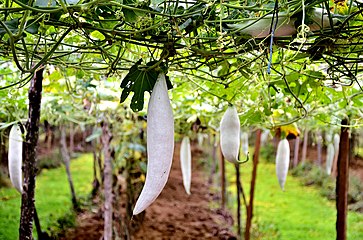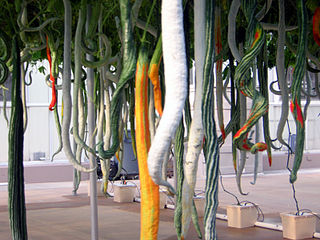
The Cucurbitaceae, also called cucurbits or the gourd family, are a plant family consisting of about 965 species in around 95 genera. Those most important to humans are the following:

Gourds include the fruits of some flowering plant species in the family Cucurbitaceae, particularly Cucurbita and Lagenaria. The term refers to a number of species and subspecies, many with hard shells, and some without. One of the earliest domesticated types of plants, subspecies of the bottle gourd, Lagenaria siceraria, have been discovered in archaeological sites dating from as early as 13,000 BCE. Gourds have had numerous uses throughout history, including as tools, musical instruments, objects of art, film, and food.

Cucurbita is a genus of herbaceous fruits in the gourd family, Cucurbitaceae, native to the Andes and Mesoamerica. Five edible species are grown and consumed for their flesh and seeds. They are variously known as squash, pumpkin, or gourd, depending on species, variety, and local parlance. Other kinds of gourd, also called bottle-gourds, are native to Africa and belong to the genus Lagenaria, which is in the same family and subfamily as Cucurbita, but in a different tribe. These other gourds are used as utensils or vessels, and their young fruits are eaten much like those of the Cucurbita species.

A melon is any of various plants of the family Cucurbitaceae with sweet, edible, and fleshy fruit. The word "melon" can refer to either the plant or specifically to the fruit. Botanically, a melon is a kind of berry, specifically a "pepo". The word melon derives from Latin melopepo, which is the latinization of the Greek μηλοπέπων (mēlopepōn), meaning "melon", itself a compound of μῆλον (mēlon), "apple", treefruit " and πέπων (pepōn), amongst others "a kind of gourd or melon". Many different cultivars have been produced, particularly of cantaloupes.

Cucurbita pepo is a cultivated plant of the genus Cucurbita. It yields varieties of winter squash and pumpkin, but the most widespread varieties belong to the subspecies Cucurbita pepo subsp. pepo, called summer squash.

Calabash, also known as bottle gourd, white-flowered gourd, long melon, birdhouse gourd, New Guinea bean, Tasmania bean, and opo squash, is a vine grown for its fruit. It can be either harvested young to be consumed as a vegetable, or harvested mature to be dried and used as a utensil, container, or a musical instrument. When it is fresh, the fruit has a light green smooth skin and white flesh.
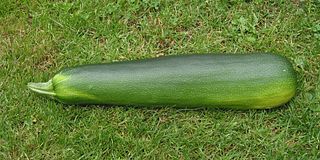
A marrow is a fruit used as a vegetable, the mature fruit of certain Cucurbita pepo cultivars. The immature fruit of the same or similar cultivars is called courgette or zucchini. Like courgettes, marrows are oblong, green squash, but marrows have a firm rind and a neutral flavour, making them useful as edible casings for mincemeat and other stuffings. They can be stored for several weeks after harvest, to be processed for food when required. They are a vegetable used in Great Britain and areas with significant British influence, though their popularity is waning in favor of immature summer squash like courgette.

Ficus elastica, the rubber fig, rubber bush, rubber tree, rubber plant, or Indian rubber bush, Indian rubber tree, is a species of flowering plant in the family Moraceae, native to eastern parts of South and Southeast Asia. It has become naturalized in Sri Lanka, the West Indies, and the US state of Florida. Despite its common names, it is not used in the commercial production of natural rubber.
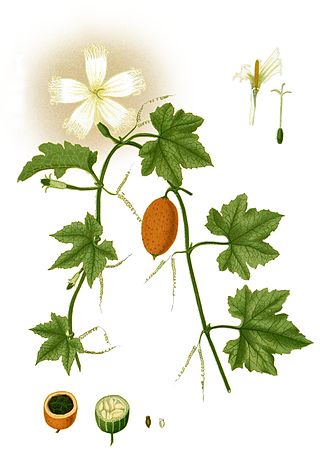
Trichosanthes is a genus of tropical and subtropical vines. They belong to the cucumber family (Cucurbitaceae), and are closely related to Gymnopetalum. Hodgsonia, formerly included here, is usually considered a well-distinct genus nowadays.

Trichosanthes dioicaRoxb., also known as pointed gourd, is a tropical perennial cucurbit plant with its origin in the Indian subcontinent. It is also known as parwal, palwal, potol, or parmalin in different parts of India and Bangladesh. The plant propagated vegetatively and grows with training on a support system as pencil-thick vines (creepers) with dark-green cordate (heart-shaped) simple leaves. It is a well-developed dioecious plants having distinct male and female flowers on staminate and pistillate plants, respectively. The fruits are green with white or no stripes' and have unpalatable seeds. Size can vary from small and round to thick and long — 2 to 6 inches. It thrives well under a hot to moderately warm and humid climate. The plant remains dormant during the winter season and prefers fertile, well-drained sandy loam soil due to its susceptibility to water-logging.

Cucurbita ficifolia is a species of squash, grown for its edible seeds, fruit, and greens. It has common names including Asian pumpkin, black seed squash, chilacayote, cidra, fig-leaf gourd, and Malabar gourd. Compared to other domesticated species in its genus, investigators have noted that samples of C. ficifolia from throughout its range are relatively similar to one other in morphology and genetic composition. Variations do occur in fruit and seed color, some isozymes, and photoperiod sensitivity.

In botany, a berry is a fleshy fruit without a stone (pit) produced from a single flower containing one ovary. Berries so defined include grapes, currants, and tomatoes, as well as cucumbers, eggplants (aubergines) and bananas, but exclude certain fruits that meet the culinary definition of berries, such as strawberries and raspberries. The berry is the most common type of fleshy fruit in which the entire outer layer of the ovary wall ripens into a potentially edible "pericarp". Berries may be formed from one or more carpels from the same flower. The seeds are usually embedded in the fleshy interior of the ovary, but there are some non-fleshy exceptions, such as Capsicum species, with air rather than pulp around their seeds.
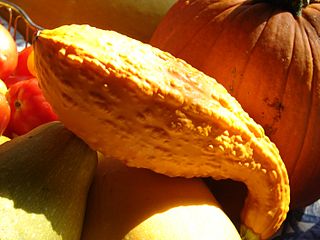
Crookneck squash, also known as yellow squash, is a cultivar of Cucurbita pepo, the species that also includes some pumpkins and most other summer squashes. The plants are bushy and do not spread like the plants of winter squash and pumpkin. Most often used as a summer squash, it is characterized by its yellow skin and sweet yellow flesh, as well as its distinctive curved stem-end or "crooked neck". It should not be confused with crookneck cultivars of Cucurbita moschata, such as the winter squash 'Golden Cushaw', or the vining summer squash 'Tromboncino'. Its name distinguishes it from another similar-looking variety of C. pepo, the straightneck squash, which is also usually yellow. There is one similar non-edible C. pepo variety: C. pepo var. ovifera.

Cucurbita foetidissima is a tuberous xerophytic plant found in the central and southwestern United States and northern Mexico. It has numerous common names, including: buffalo gourd, calabazilla, chilicote, coyote gourd, fetid gourd, fetid wild pumpkin, Missouri gourd, prairie gourd, stinking gourd, wild gourd, and wild pumpkin. The type specimen was collected from Mexico by Alexander von Humboldt and Aimé Bonpland sometime before 1817. In Latin, foetidissima means ill smelling.

Trichosanthes kirilowii is a flowering plant in the family Cucurbitaceae found particularly in Henan, Shandong, Hebei, Shanxi, and Shaanxi (China). It is one of the 50 fundamental herbs used in traditional Chinese medicine, where it shares the name guālóu with the related T. rosthornii. It is known as "Chinese cucumber" and "Chinese snake gourd" in English.
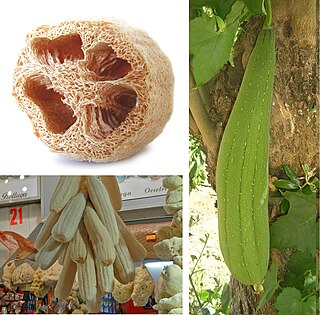
Luffa aegyptiaca, the sponge gourd, Egyptian cucumber or Vietnamese luffa, is an annual species of vine cultivated for its fruit, native to South and Southeast Asia.

Cucurbitacin is a class of biochemical compounds that some plants – notably members of the pumpkin and gourd family, Cucurbitaceae – produce and which function as a defence against herbivores. Cucurbitacins are chemically classified as triterpenes, formally derived from cucurbitane, a triterpene hydrocarbon – specifically, from the unsaturated variant cucurbit-5-ene, or 19(10→9β)-abeo-10α-lanost-5-ene. They often occur as glycosides.

Diaphania indica, the cucumber moth or cotton caterpillar, is a widespread but mainly Old World moth species. It belongs to the grass moth family, and therein to the large subfamily Spilomelinae. This moth occurs in many tropical and subtropical regions outside the Americas, though it is native to southern Asia; it is occasionally a significant pest of cucurbits and some other plants.
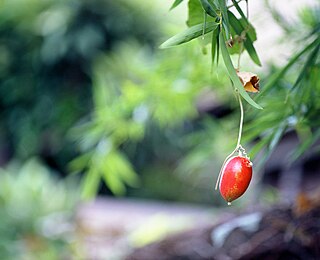
Trichosanthes pilosa is a tropical or semitropical vine bearing an edible fruit. It is native to Japan, Taiwan, India, Malaysia, Vietnam, the Philippines, China and other parts of southeast Asia as well as in Australia. It is known in English as Japanese snake gourd.

Cyclanthera brachystachya, the exploding cucumber, in the cucurbit or gourd family (Cucurbitaceae), is a herbaceous vine usually grown for its curiosity value, but the fruit is also edible.




